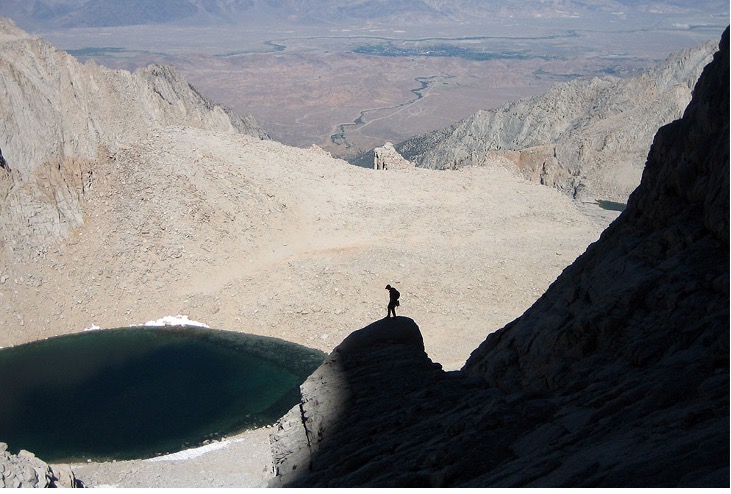CommentsTHE ENVIRONMENT - Do you want to develop the superpower of seeing decades, even centuries, into the future?
Then start hiking the High Sierra.
That’s the inescapable conclusion of a surprising new memoir from California’s greatest living science fiction writer, Kim Stanley Robinson, about how he has structured his life around backpacking in his state’s great mountain range.
The High Sierra: A Love Story is as sprawling and full of ups-and-downs as the Sierra Nevada themselves, those majestic mountains defending more than 250 miles of California’s eastern flank. The 560-page memoir offers fast-paced and highly readable explorations of Sierra history, people, geography, geology, and the ways that the range’s rocks can shift your mind.
“I knew that this granite world, holding me in its cupped hands as I lay on it, glowing luminously in the moonlight, was a magic place,” he writes of one of his regular Sierra trips, which began when he was a UC San Diego student in 1973 and continue today, from his home in Davis.
To hike into the range’s highest places was to enter an “open immense space unlike anything in my life below: an escape, a trudge up and into a higher realm. It was mind-boggling. It was as if I could choose to visit heaven.”
But the book is most powerful for demonstrating how a mountain range, and its history, can inspire visions of the future.
Robinson’s science fiction novels and stories are acclaimed for their political and environmental plausibility, their scientific grounding, their literary polish, and their optimism (even in describing future planetary catastrophes).
Reading his memoir, then, feels a bit like hearing a magician’s secrets. The mountain range, as a world apart, has a lot in common with future worlds, and how they change with the climate.
The emotional sustenance and inspiration Robinson finds in his Sierra walks clearly informed the characters in his Three Californias trilogy of novels (about three different futures of Orange County, where he grew up). Those characters are repaired and changed by their own travel to Sierra settings, from Dragon Pass to Dusy Basin.
The clearest connection between Robinson the hiker and Robinson the writer is through climate change, a focus of his 2020 masterpiece, The Ministry for the Future, about the leader of an imagined U.N. agency that is supposed to represent future generations, and an eco-terrorist who survives a heat wave in India that kills more than 20 million people.
His 2013 novel, Shaman, which imagines how people live in an ice age, owes a debt to his snow-shoeing trips in the range during winters. His 2007 novel, Sixty Days and Counting, about a president battling environmental catastrophe (including a deep freeze in Washington), imagines characters visiting the Sierra’s high meadows after they have been desiccated by climate change. His account of an attempted settlement on the moon in 2015’s Aurorais inspired by Sierra landscapes, as are some of the scenes Robinson imagines in the 2012 novel, 2312, when human society has colonized other planets in the solar system.
In the memoir, he also cops to lifting accounts of walks in his famous Mars trilogy—novels chronicling the settlement of the red planet over 200 years—from notes he’d taken in the Sierra.
“In describing the Martian landscape as if it were the High Sierra, I was really fudging it, because only by terraforming Mars could I make that cold poisonous planet into a place anything like the Sierra,” Robinson confesses. “Reviewers who wrote things like, ‘It almost seems as if Robinson has been to Mars,’ always made me laugh.”
In The High Sierra, Robinson writes about the changing of the Sierra climate, the melting of its glaciers, and the way the Arizona monsoon season has changed the summer climate of the mountain range. At one moment in the book, this utopian writer confesses to despair.
“Higher temperatures are here already, and the Sierra glaciers will soon be gone. The high country will dry out. Back home, I found myself stricken by this realization. Of course people die; I myself will die, but not the Sierras! Not the Sierras. It was too much to bear. Anguish filled my mind like smoke.” Later, a friend recounts the resilience of the Sierra, and Robinson, reassured, learns to see the mountains’ future with “fearful joy.”
Robinson, 70, expresses impatience with today’s cultural and political arguments around the preservation of land and nature. He is especially critical of the now-fashionable idea among progressives that the concept of “wilderness”—and policies to preserve “untouched” spaces like national parks—are just imperialist or colonial attempts to erase Indigenous cultures.
“The bad timing of this attack on wilderness is not a coincidence; it both displaces our historical culpability, and it shrinks our present responsibility,” he writes.
Pushing back against this current perspective, Robinson argues for the long view—and for expanding those areas designated as wilderness.
The preservation of the Sierra—and especially the unbroken wilderness from Tioga to the far south of the range—is the sort of achievement that must be emulated, at a global scale, he writes. Near the book’s conclusion, he embraces movements for leaving a big portion of the Earth’s surface free of human impacts—including the late biologist E.O. Wilson’s proposal to leave half the earth empty of human beings. It’s the only way, argues Robinson, to save animals and plants and our own human descendants, “who otherwise might be given a world wrecked by our ecocide.”
In the future, California’s great novelist of the future imagines, the Sierra could be a big, early link “in the habitat corridors that eventually will stretch from the Yukon to Tierra del Fuego, as part of a worldwide network of protected land that will help to keep innumerable species from extinction—this is beautiful.”
(Joe Mathews writes the Connecting California column for Zócalo where this article was published.)
















